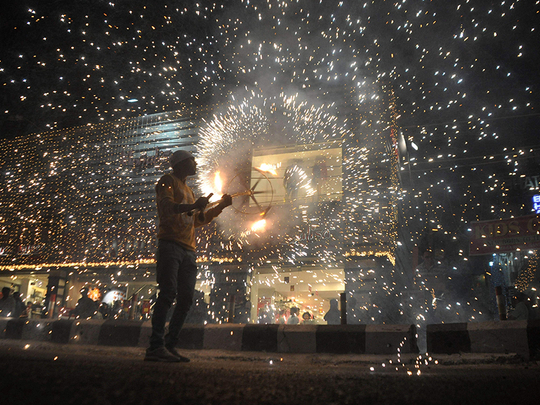
New Delhi: Pollutant-loaded air continued to hang heavy in the national capital ahead of Diwali, prompting authorities to call for the festivities to exclude fireworks, which they said emit cancer-causing smoke.
Nearly all the monitoring stations active in the city said the PM 2.5 and PM 10 (ultra fine pollutants) were several times above the safe limit of 60 and 100 micro grams per cubic metre, keeping the city air in “very poor” category.
For the second consecutive day, pollutants (PM 10) in Anand Vihar shot up nine times above the safe limit when checked in real-time around 12 PM as per the Delhi Pollution Control Committee (DPCC).
Central Pollution Control Board’s (CPCB) Punjabi Bagh, RK Puram stations had the Air Quality Index (AQI) in the severe category, which affects healthy people and seriously impacts those with existing diseases.
System of Air Quality and weather Forecasting and Research (SAFAR), Pune, said in its Diwali forecast that if the current weather conditions prevailed, share of PM 2.5 would increase by up to 20 per cent.
According to SAFAR analysis, wind, which is already stagnant, is likely to turn easterly during the Diwali period. This coupled with falling temperature is likely to worsen the pollution level in the city.
“This scenario is likely to hold the locally generated firecrackers emissions within the NCT [National Capital Territory of Delhi], slowing down dispersion, resulting in increased levels of PM 2.5 and PM 10 pollution unlike 2015 when winds swept away the larger share,” a report prepared by a team of SAFAR, led by Gufran Beig, said.
The highest levels of PM 10 and PM 2.5 are expected between 11pm and 3am on the night of October 30 and 31. Air quality will be at its worst on October 31 and start to improve from November 1, the agency said.
Centre for Science and Environment’s (CSE) Anumita Roychowdhury said the carcinogenic element in the smoke emitted by firecrackers may cause diseases ranging from cancer to imbalance of hormones.
In October, the share of poor air quality days have increased to 27 per cent, that of very poor to 57.7 per cent. In addition, 3.8 per cent of days have already experienced severe pollution, CSE said.
“A soon to be released UNICEF report shows how children are extremely vulnerable to firecrackers. It is not about Chinese or Indian crackers. The government needs to start working with the licensing authority and limit the amount of crackers sold. The data is scary,” Rowchowdhury said.
She said India should mull measures like that of Beijing where emergency measures kick in when air quality turns poor.
“China does not allow crackers when Beijing’s pollution levels are as high as Delhi’s. There are provisions of heavy penalties in United Kingdom,” she said.
CSE also observed that these killer particles have already increased by nearly two times since September and that there were more number of days in ‘very poor and severe’ categories.
“Toxic fumes from fireworks will only worsen this trend and will deposit deadly chemicals in our environment that will remain trapped for days after,” it said.
The Delhi government had yesterday warned of a “critically polluted” period ahead.












